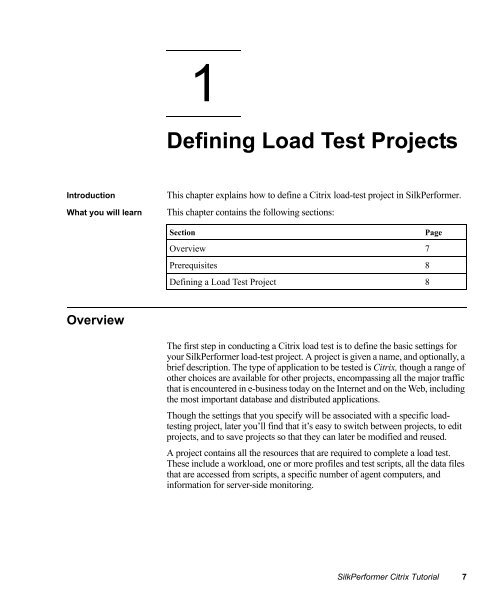SilkPerformer Citrix Tutorial - Borland Technical Publications
SilkPerformer Citrix Tutorial - Borland Technical Publications
SilkPerformer Citrix Tutorial - Borland Technical Publications
You also want an ePaper? Increase the reach of your titles
YUMPU automatically turns print PDFs into web optimized ePapers that Google loves.
1<br />
Defining 1Chapter<br />
Load Test Projects<br />
Introduction<br />
What you will learn<br />
This chapter explains how to define a <strong>Citrix</strong> load-test project in <strong>SilkPerformer</strong>.<br />
This chapter contains the following sections:<br />
Section<br />
Page<br />
Overview 7<br />
Prerequisites 8<br />
Defining a Load Test Project 8<br />
Overview<br />
The first step in conducting a <strong>Citrix</strong> load test is to define the basic settings for<br />
your <strong>SilkPerformer</strong> load-test project. A project is given a name, and optionally, a<br />
brief description. The type of application to be tested is <strong>Citrix</strong>, though a range of<br />
other choices are available for other projects, encompassing all the major traffic<br />
that is encountered in e-business today on the Internet and on the Web, including<br />
the most important database and distributed applications.<br />
Though the settings that you specify will be associated with a specific loadtesting<br />
project, later you’ll find that it’s easy to switch between projects, to edit<br />
projects, and to save projects so that they can later be modified and reused.<br />
A project contains all the resources that are required to complete a load test.<br />
These include a workload, one or more profiles and test scripts, all the data files<br />
that are accessed from scripts, a specific number of agent computers, and<br />
information for server-side monitoring.<br />
<strong>SilkPerformer</strong> <strong>Citrix</strong> <strong>Tutorial</strong> 7

















